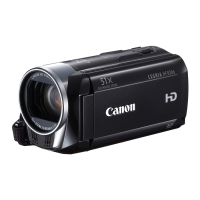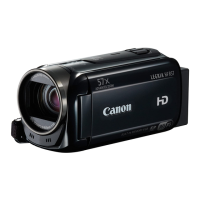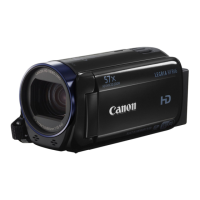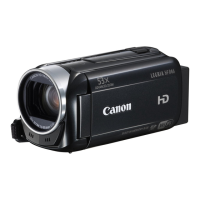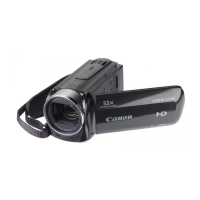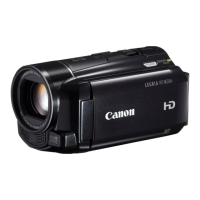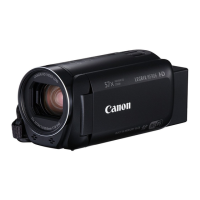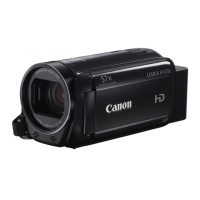
Do you have a question about the Canon LEGRIA HF R306 and is the answer not in the manual?
| Sensor type | CMOS |
|---|---|
| Total megapixels | 3.28 MP |
| Optical sensor size | 1/4.85 \ |
| Effective megapixels (image) | 2.07 MP |
| Digital zoom | 1020 x |
| Optical zoom | 32 x |
| Image stabilizer | Yes |
| Focal length range | 2.8 - 89.6 mm |
| Interchangeable lens | - |
| Image stabilizer type | Optical Image Stabilization (OIS) |
| Maximum aperture number | 4.5 |
| Minimum aperture number | 1.8 |
| Focal length (35mm film equivalent) | 38.5 - 1232 mm |
| Maximum focal length (35mm film equiv) | 1232 mm |
| Minimum focal length (35mm film equiv) | 38.5 mm |
| Memory slots | 1 |
| Camcorder media type | Memory card |
| Compatible memory cards | SD, SDHC, SDXC |
| Maximum memory card size | 64 GB |
| Internal storage capacity | 0 GB |
| Focus adjustment | Auto/Manual |
| Closest focusing distance | 0.1 m |
| Scene modes | Beach, Fireworks, Night, Portrait, Snow, Sports, Spotlight, Sunset |
| Built-in flash | No |
| Shutter speed (video) | 0.001 s |
| Display diagonal | 3 \ |
| Display resolution (numeric) | 230000 pixels |
| Viewfinder type | Not available |
| Camcorder type | Handheld camcorder |
| Image processor | DIGIC DV III |
| Self-timer delay | 10 s |
| Minimum illumination | 4 lx |
| Product color | Black |
| Capture modes | FXP, MXP, SP, XP+ |
| Video resolutions | 1280 x 720, 1440 x 1080, 1920 x 1080 pixels |
| Video formats supported | AVCHD, MP4 |
| Maximum video resolution | 1920 x 1080 pixels |
| Audio system | Dolby Digital 2.0 |
| USB 2.0 ports quantity | USB 2.0 ports have a data transmission speed of 480 Mbps, and are backwards compatible with USB 1.1 ports. You can connect all kinds of peripheral devices to them. |
| USB 3.2 Gen 1 (3.1 Gen 1) Type-A ports quantity | 0 |
| Battery capacity | - mAh |
| Battery life (max) | - h |
| Video recording time | 1 h |
| Cables included | USB |
| Depth | 115 mm |
|---|---|
| Width | 54 mm |
| Height | 55 mm |
| Weight | 250 g |
Information on proper disposal of product in the EU/EEA according to WEEE Directive.
Declaration of conformity with essential requirements of Directive 1999/5/EC.
Enables wireless transfer of recordings for sharing and backup.
Create compelling video stories using pre-scripted suggestions.
Apply professional filters to create unique movie looks.
Record in AVCHD for HDTV or MP4 for web and mobile.
Record short scenes and arrange into a clip with background music.
Automatically detects faces and adjusts settings for beautiful results.
Save camcorder memory content to an external hard drive.
Compensates for camcorder shake for stable shots.
Explains symbols, notes, and terms used throughout the manual.
Lists and illustrates the accessories and CD-ROMs included with the camcorder.
Identifies and labels the various parts and terminals of the camcorder.
Basic steps to start using the camcorder.
Instructions on how to charge the camcorder's battery pack.
Details on how to rotate the LCD panel for different viewing angles.
Explains how to interact with the camcorder using the touch screen.
Overview of the HOME menu and its available control buttons.
Access commonly used shooting functions like focus and exposure.
Access settings like video quality and LCD brightness.
Select between AUTO, Manual, or Cinema modes for recording.
Choose between AVCHD or MP4 recording standards for movies.
Guide to setting the camcorder's internal clock and date.
Instructions for changing the camcorder's display language from default English.
How to set the camcorder's time zone to match your location.
Details on compatible SD, SDHC, and SDXC memory card types and speed classes.
Step-by-step guide on how to insert and remove memory cards.
How to choose between built-in memory or a memory card for recording.
How to initialize memory cards or built-in memory to delete data.
How to record video and take photos using AUTO mode.
Explains how the camcorder automatically detects scene characteristics.
How to use the physical zoom lever on the camcorder.
How to operate zoom using the touch screen controls.
How to play back recorded movies on the camcorder.
Steps to select and play back recorded video scenes.
How to delete individual video scenes from playback.
How to delete multiple scenes directly from the index screen.
Guide to using Story Creator for making themed video stories.
Steps to start a new video story using the Story Creator function.
How to add decorations to scenes while recording video.
Instructions to access the story gallery for playback.
How to choose a story from the gallery for playback.
How to rate scenes right after recording them.
How to rate scenes by accessing them from the list.
Step-by-step guide for copying or moving scenes within or between stories.
How to manually adjust settings like exposure and focus.
How to use Powered IS for enhanced image stabilization.
How to select the main subject for optimized focus and settings.
Procedure to set a custom white balance using a white object.
How to capture short scenes from a movie as video snapshots.
How to view photos stored on the camcorder or memory card.
Jump easily through photos using the scroll bar for quick browsing.
How to delete individual photos from single photo view.
How to delete multiple photos from the index screen.
Identifies the AV OUT, HDMI OUT, and USB terminals on the camcorder.
Illustrates how to connect the camcorder to external devices via HDMI.
How to connect the camcorder to a standard TV or VCR using composite video.
How to connect the camcorder to a computer or external hard drive via USB.
Steps to connect the camcorder to a TV for playback.
How to copy recordings from built-in memory to a memory card.
Instructions for saving recordings to a computer using USB connection.
Guide to installing PIXELA software for saving AVCHD movies.
Steps to connect the camcorder to a computer for file transfer.
How to install ImageBrowser EX software for saving MP4 files.
Steps to connect the camcorder for saving recordings via USB.
How to save entire memory contents to an external hard drive.
Procedure to safely end the connection before disconnecting the external hard drive.
How to play back recordings saved on an external hard drive.
Instructions for initializing an external hard drive for use with the camcorder.
Copying movies in high definition to Blu-ray recorders via USB.
Copying movies to VCRs or digital recorders using analog inputs.
Install software for converting scenes to standard definition.
How to convert multiple scenes, select bit rate, or auto divide.
Explains wireless connectivity for sending files without cables.
Connect via an access point (router) to a Wi-Fi network.
Connect directly to an iOS device without an access point.
Ensures a correctly configured Wi-Fi network or hotspot is available.
Easy, automatic setup using a wireless router's WPS button or PIN code.
Manually configure settings if WPS is not supported or network is hidden.
Set destination for wireless file transfers to a Windows computer.
Configure settings for transferring files wirelessly to an FTP server.
Lists functions available in the Main Functions panel for recording modes.
Lists available camera setup options and their functions.
Essential checks before proceeding to detailed troubleshooting steps.
Solutions for camcorder not turning on or turning off by itself.
Troubleshooting recording mode, memory card insertion, and general issues.
Troubleshooting playback mode and memory card issues.
Solutions for failure to start recording, full memory, or scene limits.
Troubleshooting autofocus issues and lens cleaning.
Solutions for inability to copy/move scenes due to full memory.
Cannot delete scenes recorded or edited on other devices.
Reasons why video snapshot scenes cannot be captured from movies.
Solutions for a dim LCD screen, adjust backlight settings.
Troubleshooting screen display issues related to battery pack.
Steps to resolve abnormal characters and operational problems.
How to reduce video noise by adjusting camcorder placement.
Solutions for horizontal bands caused by fluorescent lighting.
How to prevent audio distortion with loud sounds or low levels.
Correcting issues with memory card insertion direction.
Solutions for full memory cards, incorrect initialization, or LOCK switch.
Troubleshooting Eye-Fi card wireless upload issues.
Reducing video noise by adjusting distance from TV and power adapter.
Ensuring correct video input is selected on the TV.
Resolving HDMI connection issues by reconnecting or power cycling.
Troubleshooting HDMI-CEC function and remote control issues.
Resolving computer connection issues by changing USB port or reconnecting.
Troubleshooting photo transfer limits and using card readers.
Message indicating the importance of backing up recordings regularly.
Error indicating built-in memory could not be read; contact service.
Message indicating built-in memory is full; delete or save recordings.
Message for interrupted writing to built-in memory; prompts data recovery.
Error indicating a problem with built-in memory; contact service.
Message about incompatible or faulty battery packs.
Errors related to memory card access, file name creation, or MMC insertion.
Memory issues preventing playback; contact service if persistent.
Memory card issues; save recordings, initialize, or use different card.
Built-in memory initialized by computer; re-initialize with camcorder.
Memory card compatibility or initialization issues.
Error during writing to external drive; prompts data recovery.
Warning about initializing external hard drive; data will be lost.
Connection ended due to power loss; check for data corruption.
FTP transfer failure; retry after restarting devices.
Network Utility transfer failure; retry after restarting devices.
Regularly transfer and save recordings to an external device for protection.
Avoid excessive force and use only the stylus pen on the touch screen.
Do not use protective film as it may affect touch screen operation.
Avoid exposing the camcorder to extreme temperatures or humidity.
Avoid using the camcorder near strong electromagnetic fields like TVs or phones.
Avoid Wi-Fi use in sensitive environments like hospitals or aircraft.
Keep distance from devices like cordless phones to reduce Wi-Fi interference.
Avoid pointing the lens at strong light sources.
Store battery packs in a dry place and discharge them before storing.
Notes on battery time display accuracy with optional packs.
How to recharge the built-in battery by connecting the compact power adapter.
Instructions for cleaning the camcorder body, lens, and LCD touch screen.
How condensation forms and what to do when it is detected.
Information on using the compact power adapter in different countries.
Notes on PAL system TV compatibility for playback in various regions.
Lists and illustrates supplied and optional camcorder accessories.
Details on selecting and using optional battery models like BP-718/BP-727.
Information on using the CG-700 battery charger for battery packs.
Approximate recording and playback times for AVCHD movies using built-in memory.
Details on recording system, video compression, and audio compression.
Information on AVCHD and MP4 video signal configurations.
Details on built-in memory and compatible memory card types.
Approximate maximum recording times for AVCHD and MP4 movies.
Details on the AV OUT terminal for audio/video and headphone output.
Specifications for the mini-AB, Hi-Speed USB output terminal.
Details on the HDMI mini connector output terminal with HDMI-CEC.
